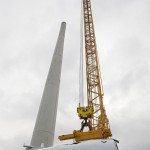Wind power growth expected to slow in 2013, but recovery predicted
 Strong markets in China, India and Brazil, and new markets in Latin America, Africa and much of Asia will drive growth in the wind industry over the next five years, according to a new report from the Global Wind Energy Council (GWEC), which warns that investment in Europe could falter if renewables policies fail to offer stability.
Strong markets in China, India and Brazil, and new markets in Latin America, Africa and much of Asia will drive growth in the wind industry over the next five years, according to a new report from the Global Wind Energy Council (GWEC), which warns that investment in Europe could falter if renewables policies fail to offer stability.
Record installations in the US and Europe in 2012 led to installations of 44.8 GW of new wind power globally. This was 10% more than was installed in 2011, meaning that global installed capacity has now reached 282.5 GW, a cumulative increase of almost 19%.
The US wind energy industry had its strongest year ever, connecting over 13.1 GW of new wind power capacity from 190 projects, beating China to regain the top spot among global markets for the first time since 2009. Europe also had a good 12 months with 12,744 MW of wind power installed across the continent with EU countries accounting for 11,895 MW of the total.
The forecast globally is for a modest downturn in 2013, followed by a recovery in 2014 and beyond, with global capacity growing at an average rate of 13.7% until 2017, and global capacity nearly doubling to 536 GW.
However, this growth is almost certain not to be led by the old world. In 2012, “for the first time in three years, the majority of installations were inside the OECD,” says the report, but its authors suggest that “in retrospect this will look like a blip on the graph”.
Policy uncertainties in the EU will be partly to blame. “European governments are driving up the cost of meeting their 2020 renewable energy targets by making policy changes that undermine investor confidence,” says Thomas Becker, CEO of EWEA.
Steve Sawyer, GWEC secretary general, supports this stance. “Wind power may be variable, but the greatest threat to the continued stable growth of the industry is the variability and unpredictability of the politicians who set the frameworks for the energy sector,” he says.
However, globally, “all of the fundamentals which have driven wind power to date are still in place: energy security, price stability, local economic development, climate change mitigation and local air and water pollution issues,” Sawyer insists. Moreover, “wind is now competitive in an increasing number of markets, despite fossil fuel subsidies which last year amounted to an incentive to emit CO2 of about $110/tonne,” says Sawyer.
It is the new world therefore that is poised to reap the biggest benefits from all this. After a year of market consolidation in China, the world’s largest market with over 75 GW of installed capacity, plans 18 GW of installations in 2013. Likewise, after a year-long policy hiatus in India, the market is expected to recover and return to growth in 2014. Brazil continues to lead the Latin American market, and may surpass 2 GW of annual installations in 2013; and both Mexico and Canada are expected to grow substantially over the period.
There are also hundreds of MW under construction in South Africa, with another 500 MW expected to come to financial close this year, leading a surge in installations in sub-Saharan Africa which began in Ethiopia in 2012. In Asia, Pakistan, Mongolia, the Philippines and Thailand are all expected to see significant installations in 2013 and beyond.






